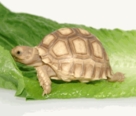Speke's Hingeback Tortoise - Kinixys spekii

KinixysSpekii, commonly known as Speke’s Hinge-back Tortoise belongs to Testudinidae family and is mostly found in Africa and also called The African Hinge-back Tortoise. They are the most likeable of the 6 African Hinge-backed tortoise species. An elongated carapace, which can go up to 20 cm in length, is flattened and weak, neither strongly toothed nor reverted. The classic curves, the full functioning hinge on the shell and lots of complementary color variations, all the features add to the beauty of this tortoise. The difference between the male and female Kinixys Spekii is that the male has a longer tail than female and also female owns a flat plastron, yet males have a more concave one. The carapace of juveniles has a zonary patter, each shield having a dark brown center with concentric light and dark zones. Males turn out to be very aggressive during breeding and often injure female counterparts. During mating, hints of pinks and blues become visible on the heads and necks of adults. A female can lay up to 2 to 4 eggs and can produce numerous clutches in a breeding season. It takes three to four months for the eggs to hatch. The hatchlings tend to be 1.5 to 2 inches long at birth. Their life span varies from 20 to 50 years. This species play the role of a host for many ectoparasites and endoparasites. Number of parasites infest and infect this species. They are friendly tortoises and prove to be nice pet for the beginners.
Kinixys Spekii Habitat
From Kenya to Swaziland, from Mozambique to Zululand, the Speke’s Hinge-back Tortoise is found in every part of Africa. It inhabits savannahs; coastal plains, dry bushes and dune forests with rocky areas. For the artificial habitat for the hatchlings, a 20 gallon aquarium is sufficient as they do not grow at a rapid speed. A mixture of peat moss, mulch or sand can be including in the enclosure because they are good at holding the moisture. Hiding places should also be provided as hiding in the enclosure is one of their favorite activities. 70 to 75 degree is considered to be the ideal temperature. UVB light is also essential as it helps in sustaining calcium and vitamin D levels. Water bowls are a necessity for Kinixys Spekii as they love to soak and it will help in sustaining the humidity. These tortoises do not prefer a huge amount of light so remember to supply them with shady areas.
Kinixys Spekii Diet
They are mostly herbivorous and can be fed upon lettuce and other greens. Tomato, cactus, pumpkin and mushrooms can also be added in their diet. Fruits like strawberries, watermelons, mangoes, apples etc. can also be made a part of their diet. They also eat snails and insects occasionally. Canned or soaked dog food mixed with meals can also be served as it will act as a treat for them. They usually eat in early mornings and early evenings so keep filling their home with food products so as not to keep them waiting.

Before Placing Your Order
Store InformationShipping Info
Payment Info
Return Policy
Arrive Alive Guarantee
Adoptation Policy
After Placing Your Order
Track Your OrderSecurity Safe Shopping
Compatibility Chart
Shoppers Review









